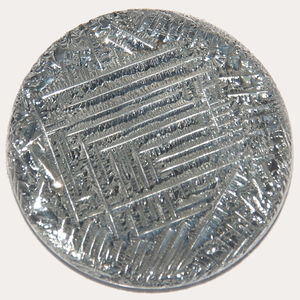Tellurium
 Metallic tellurium, diameter 3.5 cm | |||||
| General properties | |||||
|---|---|---|---|---|---|
| Name, symbol | Tellurium, Te | ||||
| Appearance |
silvery lustrous gray (crystalline), brown-black powder (amorphous) | ||||
| Tellurium in the periodic table | |||||
| |||||
| Atomic number | 52 | ||||
| Standard atomic weight (Ar) | 127.6 | ||||
| Group, block | , -block | ||||
| Period | period 4 | ||||
| Electron configuration | [Kr] 4d10 5s2 5p4 | ||||
per shell | 2, 8, 18, 18, 6 | ||||
| Physical properties | |||||
| silvery-gray | |||||
| Phase | solid | ||||
| Melting point | 722.66 K (449.51 °C, 841.12 °F) | ||||
| Boiling point | 1261 K (988 °C, 1810 °F) | ||||
| Density near r.t. | 6.24 g/cm3 | ||||
| when liquid, at | 5.70 g/cm3 | ||||
| Heat of fusion | 17.49 kJ/mol | ||||
| Heat of | 114.1 kJ/mol | ||||
| Molar heat capacity | 25.73 J/(mol·K) | ||||
| pressure | |||||
| Atomic properties | |||||
| Oxidation states | 6, 5, 4, 3, 2, 1, −1, −2 a mildly acidic oxide | ||||
| Electronegativity | Pauling scale: 2.1 | ||||
| energies |
1st: 869.3 kJ/mol 2nd: 1790 kJ/mol 3rd: 2698 kJ/mol | ||||
| Atomic radius | empirical: 140 pm | ||||
| Covalent radius | 138±4 pm | ||||
| Van der Waals radius | 206 pm | ||||
| Miscellanea | |||||
| Crystal structure | | ||||
| Speed of sound thin rod | 2610 m/s (at 20 °C) | ||||
| Thermal expansion | 18 µm/(m·K) | ||||
| Thermal conductivity | 1.97–3.38 W/(m·K) | ||||
| Magnetic ordering | diamagnetic | ||||
| Mohs hardness | 2.25 | ||||
| Brinell hardness | 180–270 MPa | ||||
| CAS Registry Number | 13494-80-9 | ||||
| History | |||||
| Naming | after Roman Tellus, deity of the Earth | ||||
| Discovery | Franz-Joseph Müller von Reichenstein (1782) | ||||
| First isolation | Martin Heinrich Klaproth | ||||
Contents
Properties
Chemical
It is usually found in -2, +2, +4 and +6 oxidation states. It has chemical properties similar to selenium, being dissolved by sulphuric and nitric acid and potassium hydroxide solutions but not in water. It corrodes copper, iron and stainless steel when it's molten. It reacts with oxygen in air, hydrogen and with halogens. It burns with a blueish grey flame. Although being mildly toxic, it is infamous for making you smell really bad so don´t handle it without correct safety equipment.
Physical
Tellurium is a whitish-silvery solid, crystalline element which has a nice, metallic luster. It's a brittle and easily powderized metalloid. It's a good semiconductor, and conductivity increases slightly when exposed to light. It melts at 450 ºC and boils at almost 1000 ºC.
Availability
Tellurium is one of the rarest stable elements on Earth's crust. Applications are scarce, most commonly used in electronics and solar panels. Prices are high and it has few uses for home chemists, in addition to collecting elements.
Production
Tellurium can be prepared by reducing tellurium compounds.
Projects
- Make tellurium dioxide
- Make sodium tellurite
Handling
Safety
Wear appropriate protection when handling it or it's compounds. Certain compounds such as cadmium telluride are highly toxic.
When small amounts are ingested, tellurium and its compounds are metabolized to dimethyl telluride, causing a foul garlic-like odor named "tellurium breath".
Storage
Tellurium should be stored in closed containers.
Disposal
It is best to try to recycle it.